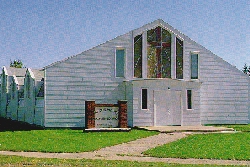

St. Hubert's Church was served by the pastor of St. Benedict. There is no record of how long the church was used.
The growth of the new hamlet of Middle Lake and the settling of new families on farms brought in enough Catholics to warrant a Catholic church in the area. Because roads were poor and it was often difficult to get even to the nearest church in a neighboring community, Catholics attended church where they could. This is evident as one looks up the registrations of baptisms and marriages of Middle Lake area residents that are recorded in the books of all the neighboring parishes, depending upon which church the family could reach by road or trail.
Catholics of the area soon delegated Martin Muller, fluent in Hungarian, German and English, to canvas the area and identify the Catholic families. Armed with Muller's list of Catholics, a delegation met with Abbot Ordinary Severin Gertken. As a result, in the summer of 1936, Fr. John Hable, resident in Marysburg and pastor of St. Bernard's Parish of old Pilger, celebrated a number of masses in the school in Middle Lake.
Then in early 1937, the first church was built on the hill just south of town on property donated by Werner Boesch. Under the supervision of Henry Livingston, Sr., the church was built with volunteer labor using lumber costing as little as $15/1,000 board feet. That building was on a surface foundation and was heated by stoves made out of gas drums. Later, a cellar was dug under it and a coal/wood furnace installed.
On Sept. 26, 1937, the church was blessed on the feast of the Canadian Martyrs' by Peta Windschiegl of St. Peter's Abbey.
In May 1957, the church was struck by lightning. The prompt and skillful help by many firefighters saved the church from serious destruction. Volunteer labor by the pastor and parishioners restored it back to use; meanwhile, the basement was being used for services, including funerals.
By April 20, 1964, the Willie Molnar land was acquired in the block east of the new school and south of the community hall. In June 1964, work got underway (again depending on volunteer labor) employing the crew of John Ilg to build and supervise. The colored windows and skylights were supplied by Glass Fibre Products of Wynyard. Unfortunately, the plant burnt down just before the last pieces were manufactured, and the plant was not available for follow up work .
Relocating the property also meant changes in the grounds. The western part of the old property the part containing the cemetery, was retained. Incidentally, the new church is closer to the cemetery than the old one. The eastern part of the old property has become the site of several modern homes.
[ Home ]
Please send comments to Carlton Trail REDA Inc.
Box 10, Muenster, Sk. S0K 2Y0![]()
[ The Humboldt Journal ][Early Humboldt]
[ St. Peter's Abbey | Agriculture | Communities ]
[ Present-day Humboldt and Surrounding Communities ]
[ Language ]
![]()